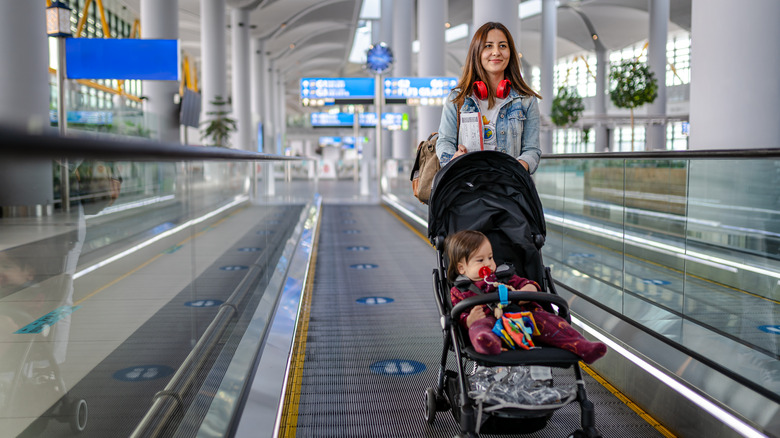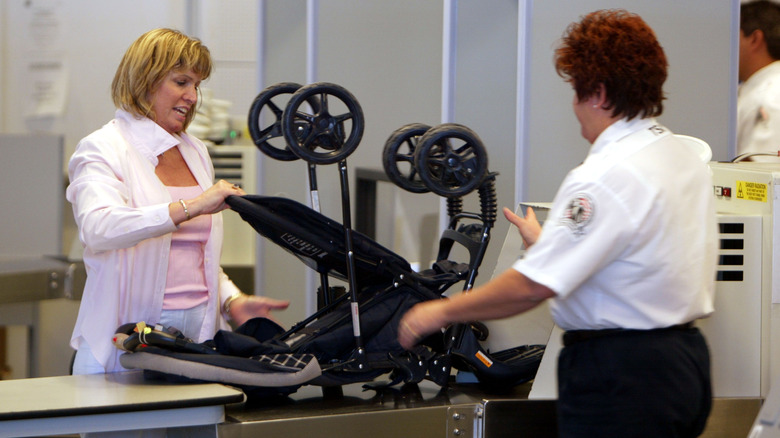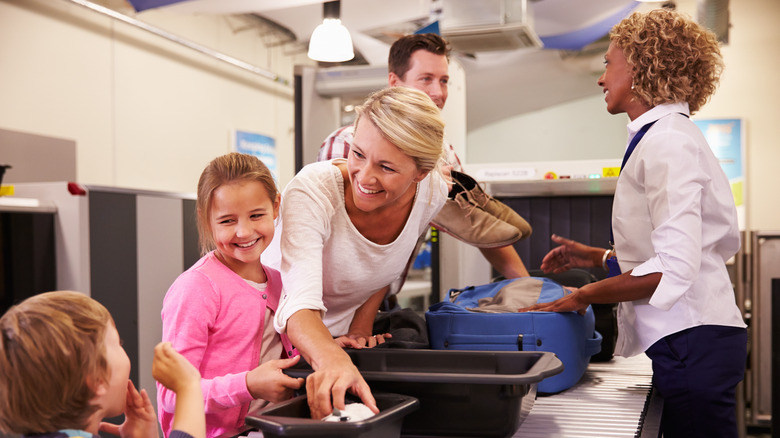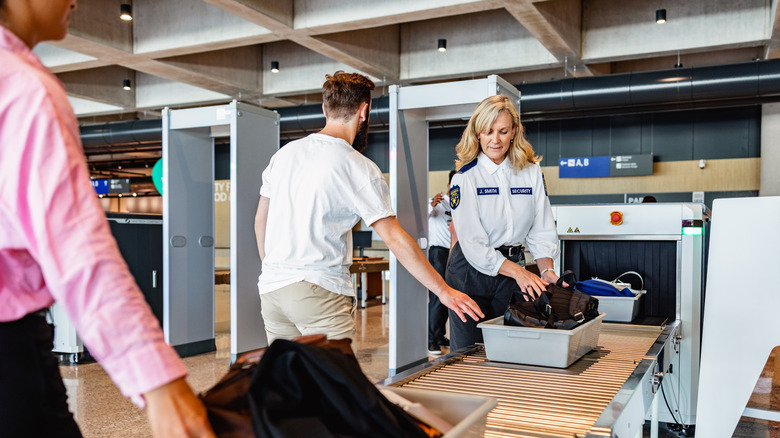The Best Way To Get Through Airport Security With Strollers And Car Seats, Per TSA
No one looks forward to going through security at the airport, and parents who need to travel with larger items like strollers and car seats may feel like they're at an additional disadvantage. If you flew prior to 2001 and don't remember things always being as strict they are now, you aren't wrong — the Transportation Security Administration (TSA) was founded in response to the national tragedy of 9/11, and is part of the Department of Homeland Security. TSA agents are present for the safety of all passengers as well as crew, but agency's strict security guidelines can be challenging, especially for families traveling with young children.
The best way to prepare for the security line is to understand that everything you bring with you to the airport and onto your flight needs to be screened by TSA (including strollers and car seats, despite their bulky nature). There is a rule and regulation for everything you bring on board, which poses a lot of questions for the average traveler. While there are varied airport hacks that can help you zip through TSA, you will probably begin your packing with a laundry list of questions: Will my stroller need to fit through the X-ray machine? Do the liquid rules apply to medication and breast milk? Can I bring nail clippers, tweezers, or a disposable razor?
While the rules may seem complicated and foreign to the average person, TSA agents know them backwards as well as forwards. Ask them any questions you need to once you arrive at the airport, but it's best to pack according to the varied safety rules and regulations that are outlined on the official TSA website so you don't run into any surprises once you're already in line.
How strollers and car seats are screened by TSA
The best strategy for travelers with larger items is to be both organized and prepared. According to the TSA website, "Strollers, umbrella-strollers, baby carriers, car and booster seats, and backpacks must be screened by X-ray." Hopefully the security line is going to move fast, so make sure you are knowledgeable in how to quickly collapse your items so they can be loaded onto the screening belt, after which they will be returned to you immediately. If any of your items are too large for X-ray, they can be visually and physically inspected by a TSA agent.
Most strollers and carriers are equipped with lots of storage for the various things that parents need to have on hand, and you can even opt for additional organizational accessories, like a stroller organizer for keeping your child's gear secure. While the additional space may be a necessity, it's also crucial to ensure all those extra compartments are free from items that need to be screened separately, like small electronics and liquids. If these rules are followed, there's no reason that your strollers and car seats will be any more challenging to travel with than a carry-on suitcase.
Yes, children can receive modified screening at the airport
TSA has a standard level of screening that all passengers must comply to, but they do offer modified screening procedures to children under the age of 12, meaning shoes, light jackets, and headwear removal is unnecessary. Passing through the metal detectors is mandatory for everyone, but these machines are approved by the FDA for use with all ages. You'll be asked to take infants and children out of their strollers and car seats, and walk through the metal detector with them in your arms.
Those 13 and older are subject to the same screening as their parents or guardians, and regardless of age, everyone's luggage and personal belongings must be screened. No one will be separated from their children, and if you have questions or are feeling uncomfortable about the process, the TSA agents are always present to assist.
Breast milk, formula, milk products, juice, teethers, medication, and baby food all fall under the category of being exempt from the 3.4-ounce liquid maximum rule, even if your child isn't present. This means that additional screening of these liquids may be necessary, but this is generally a quick and harmless process performed by a qualified TSA agent. Putting liquids like breast milk in clear bottles will help to expedite the screening process, and if your child is traveling with you, there are a few simple and effective tricks to surviving the airport with kids once you've cleared the security line.
Don't hesitate to ask for extra help from TSA
The TSA website has an entire section dedicated to special circumstances, including but not limited to the following: Disabilities and medical conditions, religion, tribal and indigenous, passenger support, military, children, seniors, civil rights, and law enforcement. While the airport may be a busy place, these agents are present to provide support and accommodation to everyone who needs it, and if you're traveling under any type of special circumstance, it's best to ask for help.
The good news is that it's not necessary to wait until you arrive at the airport to receive individualized attention from TSA. If the Frequently Asked Questions section of their website leaves you unsatisfied, AskTSA allows you to chat with a live person from 8:00 a.m. to 6:00 p.m. EST via X Post, Facebook Messenger, Apple Messages, or by texting "Travel" to AskTSA (275-872). Getting the information you need ahead of time is sure to make your next trip through the airport security line a breeze.



